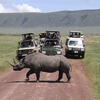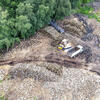You are here
Research drones in action
11.13.2024, by
Small or large, equipped with rotors or fixed wings, drones are gradually becoming part of daily life for CNRS scientists. They offer invaluable help, making it possible to see what was heretofore difficult to access, and unlike satellites doing so at low altitudes. Canopies, expanses of water, and archaeological sites have been captured for our viewing pleasure. Let us reach for the sky!

1
Slideshow mode
This group of five pilot whales–two adults and three juveniles–was immortalised during a campaign in the Mediterranean Sea by researchers from the Centre for Functional and Evolutionary Ecology. The scene unfolded in Spain, off the coast of Cartagena, during an olfactory experiment studying the sense of taste and smell of marine mammals. The results could help identify aversive molecules, for instance to keep the animals away from dangerous areas.
Bertrand Bouchard / CEFE / CNRS Images

2
Slideshow mode
Drones are also crisscrossing the skies of the Arctic. Depicted here is the Canadian Coast Guard Ship (CCGS) Amundsen, the country’s only icebreaker for research, moving through the Archer Fiord off the east coast of Ellesmere Island, in Nunavut. When it reaches its destination, the scientists on board will drop anchor and deploy a battery of oceanographic instruments to record specific measurements over an extended period, including salinity, temperature, and currents. This operation will help to study the interconnected atmosphere-ice-ocean system, and to understand the impact that ongoing changes have on marine ecosystems.
Daniel Amirault, Amundsen Science

3
Slideshow mode
Amid an almost immaculate field of green, a few stones stand out, demarcating a space. Looking more closely, we realise that the stones are actually the ruins of a funerary structure built by the first nomadic tribes of the Eurasian Steppes. Researchers from Monaco, Russia, and Mongolia took this picture in the heart of the Salbyk Valley, located in the Republic of Khakassia in the Russian Federation. Here the scientists are using drones to test new 3D modelling techniques for recording archaeological information. These include photogrammetry, which can identify the shape, dimensions, and location of an object in space based on a few photographic views.
Fabrice Monna / MAP-MC / TRACES / ARTeHIS / CNRS Images

4
Slideshow mode
These small and large rings, stretching as far as the eye can see, could be mistaken for fairy rings. The location is Saï island in Sudan, and these rings contoured in black are actually tombs. Thousands of them together form the great necropolis of Kerma. Taken from an altitude of 150 metres, the photo reveals a surface area of a little more than 2.5 hectares, with tombs dating back multiple millennia, and the largest measuring almost 40 metres in diameter.
Thomas Nicq / HALMA UMR 8164 / CNRS Images

5
Slideshow mode
In the heights above the commune of Speloncato, this experimental burn was lit and extinguished by the Northern Corsica Fire and Rescue Service. Here this aircraft is being used as a metrology instrument, with image processing identifying the successive positions of the fire, as well as the speed at which it spread.
Université de Corse Pasquale-Paoli

6
Slideshow mode
Forests viewed from the sky are always a striking spectacle. Each tree stands out from its neighbour through its colours, shape, and the surface area of its plant cover. Thanks to drones canopy photos are now common, and allow researchers, in this case from the Biodiversa+ Coforfunc project, to monitor the phenology (study of the appearance of periodic events) and functioning of forests, here in Northern Congo. The photo at right, in false colours, was also taken by a drone with a Lidar camera, a technology that uses the very precise calculation of distances and light intensity to map a 3D environment; here the colours correspond to the height of the points measured in relation to the ground.
Raphaël Pélissier, IRD/AMAP ; © Maxime Réjou-Méchain, IRD/AMAP

7
Slideshow mode
A number of checks are required before the drone takes off. Beneath this machine, which weighs 15 kg and can carry multiple on-board imaging tools (thermal, vision, and multispectral cameras, Lidar, etc.), Nicolas Barbier, a researcher at the Research Institute for Development, is making the final adjustments to this flying platform before it takes off from this inselberg (isolated hill overlooking a plain) located in Dja Faunal Reserve in Cameroon. The data collected will help to better understand the movement and distribution of fauna. The eco-guards are also taking part (photo at right). One of them, Le Bienfaiteur Sagang, who is currently a postdoctoral fellow at NASA, is trying his hand at piloting a drone and gathering Lidar data with Nicolas Barbier.
Raphaël Pélissier, IRD/AMAP ; © Vincent Droissart, IRD/AMAP

8
Slideshow mode
A running start and presto, the e-Bee type fixed-wing drone launched by Patrick Wagnon, a glaciologist with the Preshine programme (Pressures on water and soil resources in the Nepalese Himalayas), takes flight over the Changri Nup Glacier in Nepal. It will produce a 3D model of this “black” glacier, which is covered with rocky debris from the craggy slopes of its steep bed. The goal of the scientists is to measure the impact of climate variability on glaciers, to determine the evolution of the glacier’s mass balance, and to compare climate data with the uses and management of water resources by local societies, whose needs are growing.
Thibaut Vergoz / IGE / LGP / PRESHINE / IRD / CNRS Images

9
Slideshow mode
The drone is vulnerable above a body of water, even at low altitude, for one fall and the entire experiment is compromised. That is why biologists from the Centre for Functional and Evolutionary Ecology equipped their propellered colleague with buoys, like a sea plane. The one depicted here is part of the campaign to observe cetaceans in the Mediterranean. Set to an altitude of 200 meters, the drone is programmed to take a photo every two seconds, and is limited to flights of 20 minutes.
Cyril Frésillon / CEFE / CNRS Images

10
Slideshow mode
This drone, equipped with sensors, measures concentrations of carbon dioxide and methane above the Frasne peat bog in the Doubs department, as part of a campaign studying the future of this greenhouse gas. In these wetlands, organic matter does not decompose well, and accumulates in the form of peat, with the carbon being stored in this way for millennia. These ecosystems are being disrupted by climate change and human activities, their carbon capture in particular, and now tend to emit more gas. To anticipate future evolutions, the French Peatland Observation Service has been monitoring the Frasne peat bog since 2008.
Hubert Raguet / CNRS Images
Explore more
Society
Article
12/02/2025
Article
11/09/2025
Article
10/20/2025
Article
10/15/2025
Article
10/03/2025
Technology
Article
01/09/2019
Opinion
01/09/2017
Article
10/14/2015
Drones
Article
03/27/2025










